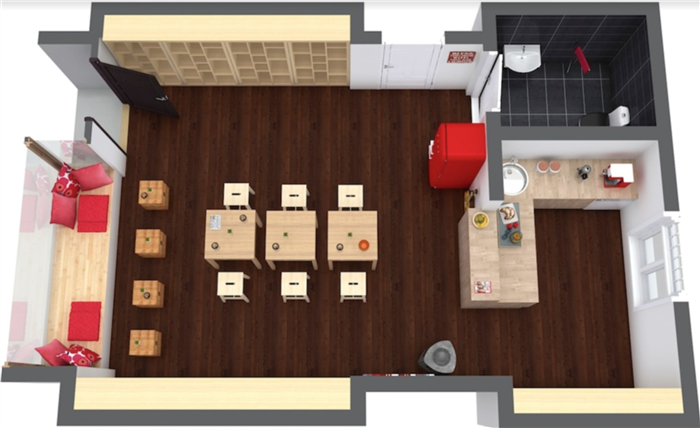Contents
13 Tips to Open a Successful Coffee Shop
Experts estimate that people drink about 2.5 billion cups of coffee a day. Sales in the ready-to-drink market—are forecast to grow by 67 percent between now and 2022. Coffee shops show incredible resilience in volatile markets and help to eliminate uncertainty in small business ownership. If you’ve been thinking of combining your love of coffee with your entrepreneurial spirit, consider opening a coffee shop.
What You Need to Open a Coffee Shop
Aside from a love of coffee, here are a few things you’ll need to get your shop up and running. Jack Wilson, owner of Radio Coffee and Beer in Austin, Texas, and Marc Renson, owner of Ambition Bistro in Schenectady, New York, offer 13 tips to prospective owners. Here’s what they recommend:
- Write a business plan
- Find the right location
- Develop a floor plan
- Hire an accountant
- Find local funding options
- Save money for personal expenses
- Compare prices and quality
- Network with lenders and other coffee makers
- Develop your marketing plan
- Focus on the Exterior
- Remain positive
- Hire slowly
- Set high standards
1. Write a business plan
The first step to starting your coffee shop is to write a business plan. This document spells out what your business is, how it will be profitable, your target market, competitors, sales projections, and goals.
Keep your business plan lean
Before creating a long-form business plan, create a one-page pitch to quickly validate your idea, understand your market, and differentiate yourself from competitors.
Browse our free coffee shop sample business plans
Check out our business plan templates for guidance. They’re free real-world examples available to download and edit as Word documents.
2. Find the best location
To be successful, you need a centrally located, highly visible space with consistent foot traffic that fits your vision. Finding the right spot may take time and effort.
Jack Wilson, owner of Radio Coffee and Beer, scoured cities, counting pedestrian traffic by hand. After months of searching, he found his spot.
Keep in mind that effective restaurant spaces are highly sought after. Take your time to find the right one.
3. Create a floor plan
A solid and welcoming floor plan is vital for a coffee shop. Visualize every scenario and put those ideas down on paper.

Demo floor plan via RoomSketcher.
Design your cafe floor plan online.
Here are a few free websites you can use to kickstart your planning process. Once you’ve drawn up an initial sketch on paper, get online and make it a reality.
Autodesk Homestyler (free): This is probably my favorite option. You can start designing your floor from scratch or choose from a gallery of designs to personalize. There’s even an option to experiment with real-world products and brands. When you’re done, share the design as part of your planning process. It can even be used as part of your pitch to potential investors.
Floorplanner: This software is clean and simple to use, with plenty of drag-and-drop furniture and other items to fill out your design. It allows for both 2-D and 3-D visualization and can be easily printed if needed.
Gliffy: While it may not be the go-to floor plan solution, I’ve included Gliffy anyway, due to it being a well-known diagram and flowchart application. If you’ve used it before, you may want to give it a try to minimize the learning curve. You can even plot out your SWOT analysis.
Hire an accountant.
One of the best pieces of advice Wilson offers to new coffee shop owners is to turn your books over to an accountant. Aside from taking valuable time away from the business, having a numbers expert works in your favor.
“You won’t be as hard on yourself as you sometimes might need to be,” Wilson says. “Plus, you will make assumptions that an accountant wouldn’t make.”
In reality, your accountant is your small business consultant. Make sure you find someone who believes in you and can help accomplish your business goals. If you’re unable to hire an accountant right away, you can also look to an online option like QuickBooks. The benefit of online accounting software is that you’ll have direct visibility into the day-to-day finances of your business. As an added benefit, it also integrates with the LivePlan business planning software, allowing you to actively compare forecasts and actuals.
Both are great options for managing your finances, and the decision fully depends on your situation and level of expertise.
Attain funding from local sources.
Finding startup funds for a coffee shop can be difficult. Renson suggests talking with friends and family about investing in your coffee shop first. Present a solid business plan to them and ask them to invest.
If funding via your family isn’t an option, or if you need more cash than your family can provide, Renson suggests looking into local loan options. In some cases, cities offer business assistance programs to offset costs. Consider an SBA-backed loan or see if a local bank or credit union is an option. Keep in mind that any bank loan will require you to show evidence that your business has some traction already. They want to know you’re a reasonable risk. So if you’re not up and running yet, there are other options for bootstrapping your business that you might consider.
Save money for your personal expenses.
When identifying startup costs, don’t forget to consider your own personal expenses alongside your business. Your time and energy will be devoted to your new business, which potentially won’t be profitable for around six months, even if you start bringing in revenue immediately.
So, plan ahead. Renson suggests making sure you set aside enough money to cover your personal expenses for at least six months if not longer. You’ll need to decide whether it’s possible to run your coffee shop while working another job or gig, or if you’ll be able to solely focus on your new business.
You will also want to understand the concept of cash flow. Considering that over half of the businesses that fail are profitable on paper when they fail, you’ll want to be sure you understand how much cash you’ll need on hand.
Shop around for everything.
While you’re in the planning and funding stages and working through your finances, keep a list or spreadsheet of all the startup expenses you’re looking at so you can compare prices.
Before you buy, try to get at least two price quotes for every item so you’re not losing money on basic necessities or recurring costs. Use the internet to your advantage and look for the best prices on everything from comfy chairs to espresso machines.
Network your heart out.
Having a hot location and brewing superior coffee will only get you so far. You need to network to maintain a connection to the area and to attract more customers. Look into joining the local chamber of commerce, a business association, or partner with a local charity. Be visible in your local community and get dedicated partners long before you open your doors.
Develop your marketing plan — before you open.
If you start marketing the day you open, you’re already behind. On opening day, you want people excited to come in. You’ll want to develop your marketing strategy and begin advertising to potential customers several months before opening.
Affordable marketing options to consider:
– Partner with other local businesses by providing free coffee in exchange for on-site advertising.
– Leverage social media as direct communication with your customers.
– Participate in local events, providing free specialty coffee samples leading up to your grand opening.
– Do a small direct mail or email campaign that sends coupons to local residents or businesses.
– Call everyone, including the media, to tell them about your plans to open the shop.

10. Don’t just focus on the interior
Stressing over every detail of your shop, from paintings to the point of sale system (POS System), can lead to neglecting the exterior. However, the exterior is crucial, especially if you have a location with heavy foot traffic. Pay attention to landscaping, signage, and appearance because that’s the first thing people see. A clean and unique exterior can create a buzz in your community, attracting attention and serving as a marketing tool.
11. Maintain a positive attitude
In the face of challenges, it’s essential to maintain a positive attitude. This not only benefits your outlook but also showcases strong leadership and a welcoming presence for customers. If necessary, fake positivity to develop the habit and eventually cultivate genuine optimism, influencing those around you to stay optimistic and ready to work.
12. Hire gradually
While you need assistance with daily tasks, avoid hiring an excessive number of people too quickly. Start by recruiting a few friends or neighbors who can volunteer during the initial weeks. As you progress, bring on staff as needed. Hiring trusted individuals can be challenging, so closely monitor their performance, especially at the register. If someone is detrimental to the business, don’t hesitate to let them go.
13. Set high standards
Establishing high standards for your employees and business is important. However, it doesn’t mean micromanaging them. Focus on effective training and building a collaborative workflow that reflects quality work. The ability of your staff to make coffee drinks quickly will influence customer loyalty and satisfaction. By prioritizing these core elements and developing your coffee shop business plan, you can set yourself up for early success and avoid long-term struggles.
Hello!
I’m Andrew Brooks, a seasoned finance consultant from the USA and the mind behind phonenumber247.com.
My career is built on a foundation of helping individuals and businesses thrive financially in an ever-changing economic landscape. At phonenumber247.com, my aim is to demystify the complex world of finance, providing clear, actionable advice that can help you navigate your financial journey with confidence. Whether it’s personal finance management, investment strategies, or understanding the nuances of market dynamics, I’m here to share insights and tools that can propel you towards your financial goals.
Welcome to my digital space, where every piece of advice is a step closer to financial clarity and success!
